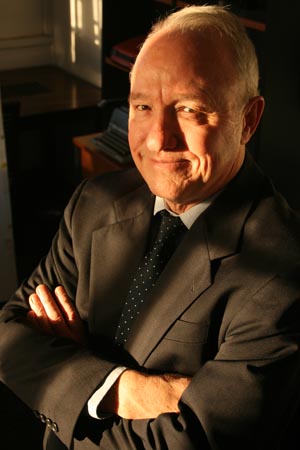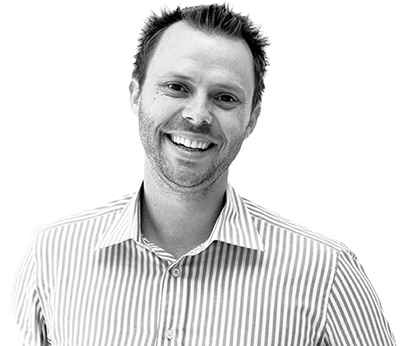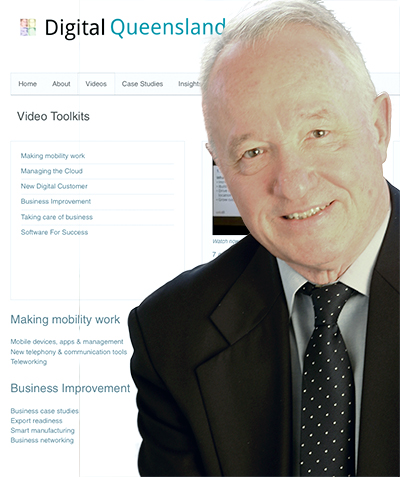Digital Business insights: Think Tanks and Do Tanks - we need both
Digital Business insights by John Sheridan >>
INNOVATION happens in laboratories and workshops in every university across the land. They are think tanks.
And innovation happens daily in the real world laboratories of small business, in the biodiversity of the marketplace. Innovation is in the very DNA of every startup and small business.
Without fresh ideas, agility, responsiveness, constant adjustment and change a business will stumble and fall. 
Most big businesses left this degree of insecurity behind years ago. They learnt lessons, improved their systems and processes and reinforced what was learned through training, reward and management.
The ability to repeat and incrementally improve is what gave the big business its edge, its ability to deliver day after day what the customer wanted. That is why it became big. Repetition and reinforcement created success.
Documented systems and training reinforced success. Over time the system became the foundation of the workforce culture, with individual workers and managers rewarded for supporting the drive to more sales, more profit and more happy customers and repeat business.
Then along came the digital revolution.
For big organisations, the advantages of being big, inflexible and consistent suddenly became disadvantages in a new fast changing operating environment.
Too big to move quickly. A culture of "more of the same". Repetition. Rusted on habits and practices.
For small organisations, the disadvantages of being small, agile and insecure, suddenly became advantages in an environment where responsiveness to change was now a valuable attribute.
Digital disruption turned the world we thought we understood upside down.
65 million years ago, a similar thing happened, when dinosaurs ruled the world, dominating the land, sea and air and only peripherally competing with small mammals, yet for reasons lost in time small mammals came out on top.
The battle for supremacy between the big and the small, the slow and the swift, the fixed and the flexible is happening again.
It is a time of massive change, of disruption, of mutation and with very few exceptions big organisations are not comfortable.
It's a time for "try and see", "plan to fail", "launch and learn" "what if?" "give it a go" And big organisations don't work like that. The CFO says 'No".
In the natural world, over time creatures steadily adapt and evolve.
External forces of various kinds, chemical, biological and radiological impact, corrupt and change DNA. Some changes confer benefit and some don't. But any beneficial change is passed on and can deliver a competitive advantage. Evolution.
The new genes deliver that advantage to succeeding generations and into the natural operational environment.
In more complex creatures it doesn't happen easily. Any change to the DNA does not go unnoticed. Various agents within the creature – the immune system, recognise extreme mutations and eliminate them.
In higher animals the immune system manages mutations effectively every day. In larger businesses the same thing is true.
In our societies innovation and new ideas (mutation) is expected in the controlled environments of universities, institutes and laboratories.
And innovation and new ideas occurs naturally in startups and small businesses. Or they fail.
But it doesn't happen easily in big businesses, governments and other large institutions. The organisational "culture", middle management and HR departments – the "immune system" – is programmed to suppress it.
We manage innovation in controlled environments with permission to innovate – universities.
We suppress innovation in big businesses, government and other large organisations.
But innovation happens freely in small business due to market forces in the cut and thrust of the real world.
That is where organisational biodiversity exists. The world of big, medium and small businesses interacting day-by-day, street-by-street, sector-by-sector, supply chain by supply chain, in state and country across the planet.
It is in the ongoing contact, communication, competition, trading, acquisition and overlap that insights arise.
Because the market is where the pressures of competition and contact inspire new ideas and actions. Where creativity is used as a tool to generate competitive advantage.
Millions of businesses in competition, contact, communication, trade and collaboration create a complex and stimulating environment that generates change, trial, failure, revision, improvement and success.
Twelve thousand years ago, we gathered seeds and fruits in their natural state wherever they could be found until one day for whatever reason some bright spark noticed the connection between seeds, germination and a plant and thought "It's hard work searching for fruit all the time, maybe I can grown the fruit right here" and off we went. Agriculture.
We recognised the value of what had arisen through biodiversity and natural selection and appropriated it for our own use.
The fruit, animals and fish all originated in the natural environment. We just noticed them, observed them, harnessed them, selected, shaped and managed them in more controlled and productive environments – farms, fisheries and nurseries.
Over time we refined the seeds, plants, fish and animals by favouring changes and mutations that suited us.
Yet we still found value in harnessing both environments - the wild and the nurtured - and we still do today.
Having access to these two conditions suits us. We get the benefit of scale, biodiversity and complexity in the natural world, and controlled selection in farms and nurseries.
But the underlying evolutionary inclination towards continual "mutation" – creating new plants, animals and varieties is what drives change in both environments.
In business, the pressure to change, to experiment, to innovate comes from the ongoing search for competitive advantage.
Bright ideas. Bad ideas. Weird ideas. Good ideas. Any ideas. "What if?"
In universities, both science and art are about discovery - research, creation, and exploration of ideas.
And discovery is what happens when a bright idea, a "mutation" – something new - arises and is pursued.
In our society, universities, institutes and colleges must be allowed to originate – to research for the sake of enquiry and discovery.
But what businesses and industry needs most is knowledge and technology applied in solving a particular or immediate problem, or to increase productivity, profitability, efficiency or whatever.
So we need two things – pure research with few if any limiting conditions and we need brokerage to match-make industry issues and needs against a variety of possible solutions, many of which may exist already.
For a healthy society with a long-term future, we shouldn't be putting unnecessary limits on what universities are researching.
We need to fund them appropriately not defund them.
We don't know what we don't know. We don't know what we may need.
But we also need to leverage the largely untapped resource of existing research papers, innovations and inventions in a far more intelligent and organised manner.
We have "think tanks" – universities and institutes.
We now need "do tanks" – places where ideas can be refined and applied to business and industry needs in a rational, national and structured manner. And I don't mean incubators, or Institutes, Growth Centres or CRCs. Useful though they all may be.
I mean something completely new that connects to and joins up all the existing good bits, the "thinking" bits including the incubators, TAFEs, universities, CRCs, Growth Centres, Institutes and CSIRO to deliver something really productive and valuable for Australian industry and small business = producing growth and jobs.
Not just sloganising about growth and jobs, but creating the conditions for growth and jobs.
There is a gap between "ideas", "talk" and "action" in Australia that is not being bridged effectively. Everybody knows the gap is there, but it seems that nobody has the time, money, remit or responsibility to bridge it.
"It's not our job, but something needs to happen. Germany does it well, The USA does it well, but we don't." That is not good enough.
We have heard this statement from professors in universities, from senior staff in CSIRO, directors in government, CEOs in industry...all sorts of people. The problem has been recognised and identified, but nobody will pick up the ball and run with it.
Connecting ideas to action could and would produce an incredibly fertile environment to stimulate growth and create jobs...the very thing government has as its current mantra.
But we need less talk, more action.
We need 'do tanks"
Places where ideas can be germinated and grown. Where good ideas can be selected and shared. Where specific knowledge can be transferred in a structured way.
In this context, universities are not "do tanks". Nor should they be.
A "do tank" is something different. And it is not a CRC or a Growth Centre, or an incubator or a TAFE. It is a broker, wholesaler and retailer for all of them.
A do tank is a place where ideas, innovations and inventions can be aggregated, matched against a set of defined industry needs, and where technology transfer can take place directly, or be enhanced in some way through engineering and design.
A do tank is a place where the big academic and research institutions can interface with SMEs, sole operators, startups and contractors.
Bridging the gap between "We are big and I don't get out of bed for less than $10,000 and "I'm small and what can I do on the smell of an oily rag".
Bridging the gap between, "I might be able to fit you into the diary in three months time when term ends" and " I need this by the end of next week or sooner."
A do tank is a place that can present new ideas, innovation and inventions as options for industry to consider – complementing the hard work done by the public libraries and ABC's Catalyst and Landline in presenting and showcasing innovation to industry and the general public.
A do tank is a place where investors and venture capitalists (should such mythical creatures really exist in Australia) can find a showcase of Australian ideas, innovations and inventions created in the economic biosphere of the marketplace by SME's, startups and individuals.
A do tank is a place where Australian innovators and entrepreneurs might find material to explore and commercialise, a place where they can meet and consider collaboration with like minds.
A do tank might well operate as an extension of the current design, engineering or creative industries precincts, managing the gap between customers of all kinds – consumers, manufacturers, industry and entrepreneurs and the knowledge resource.
Give the engineering and creative industries precincts the money and the remit and they could deliver the goods.
A do tank is something that bridges the deep gulf between universities, industry, SME, CSIRO, the Growth Centres, the libraries, schools and the hordes of specialist consultants.
It should be customer driven, grass roots up. It would allow any startup and SME to walk in the door and walk away with value.
It would be a catalyst for growth and 21st century job creation at a time when 20th century jobs are evaporating before our eyes.
It should be a research showcase for universities that attracts enquiry not pushes existing square pegs (completed research) into round holes (I have a problem). Tailoring not off the shelf.
It should be a "matchmaking" place, where the customer is helped to define problems clearly and pointed to the right solution, consultant, expert or partnership and only if necessary – generating a new research option.
It should be a hub for collaboration.
It should be a brokerage that helps a business to decide on one of three options – "do it yourself", "do it with me" and "do it for me".
"What research, innovation or improvement could I and should I do myself, in-house?"
"What idea or innovation could be enhanced by an engineering or creative industry partnership?"
"What are the big picture, new issues, common to many businesses or industries that should be addressed in a university?"
Partnership between universities, institutions and industry can then happen organically.
A two way street. A three way street. A many way street.
We need the best from the real world and the best from the academic world brokered for the good of both.
The market won't fix this issue. It's good at jungles not farms. This is one for government.
And guess what? We have the technology, the partnerships and the intelligent resources to create such a knowledge-sharing environment today.
But do we have the leadership to do it?
John Sheridan is CEO of Digital Business insights, an organisation based in Brisbane, Australia, which focuses on helping businesses and communities adapt to, and flourish in, the new digital world. He is the author of Connecting the Dots and getting more out of the digital revolution. Digital Business insights has been researching and analysing the digital revolution for more than 15 years and has surveyed more than 50,000 businesses, conducting in-depth case study analysis on more than 350 organisations and digital entrepreneurs.

 How to resolve AdBlock issue?
How to resolve AdBlock issue? 


